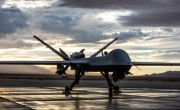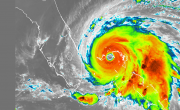Winter 2021 | The three-day HFIP Annual Meeting 2020 was held virtually on November 17-19, 2020. Approximately 130 participants from NOAA line offices, DTC, NCAR, and university partners participated in the meeting. NOAA/NWS/OSTI Modeling Program Division Director Dr. Dorothy Koch kicked off the meeting with welcoming remarks. Day one focused on HFIP programmatic updates, a discussion of forecasters' needs and current activities supporting operations and a summary of the results from the forecasters' HFIP display survey. Day two… Read More
Director's Corner: The Age of EPIC: What does this mean for DTC?
Gretchen Mullendore

Winter 2021 | In 2017, Congress instructed NOAA to establish the Earth Prediction Innovation Center (EPIC) to advance “observational, computing, and modeling capabilities to support substantial improvement in weather forecasting and prediction of high impact weather events.” What will the details of EPIC look like? EPIC has not yet been formed, so the community doesn’t know, and it’s not yet clear that NOAA knows either. Hopefully, it can achieve its goal to improve accessibility to the operational code and data so that scientists… Read More
Who's Who: Tatiana Burek
Winter 2021 | Many of you may know Tatiana Burek as the developer and gatekeeper of METviewer, the visualization software for the verification package developed and supported by the DTC, but her life took a series of turns to arrive at the DTC. She grew up in Leningrad, Russia where she spent her childhood as a passionate competitor, both as a speed skater and swimmer, all while attending rigorous dance classes. Undaunted by year-round swim team practice sessions in the outdoor pool, whose coach… Read More
Bridges to Operations: Upcoming UFS Metrics Workshop

Winter 2021 | The Developmental Testbed Center (DTC), in collaboration with the National Oceanic and Atmospheric Administration (NOAA) and the Unified Forecast System's Verification and Validation Cross-Cutting Team (UFS-V&V), is hosting a three-day workshop to identify key verification and validation metrics for UFS applications. The workshop will be held remotely 22-24 February, 2021. Approximately 275 participants have registered for this event from across the research and operational… Read More
Visitors: DTC Visitor Program Xuguang Wang
VIsitor: Xuguang Wang
Winter 2021 | Dr. Xuguang Wang is a Robert Lowry Chair Professor and Presidential Research Professor of School of Meteorology of University of Oklahoma. She leads a Multiscale data Assimilation and Predictability (MAP) lab. Her MAP research includes (a) developing new techniques and novel methodologies for data assimilation and ensemble prediction; (b) applying these techniques for global, hurricane, and convective-scale numerical prediction systems that assimilate a variety of … Read More
Community Connections: Building a Community through UFS Medium-Range Weather Application Users’ Training

Winter 2021 | The DTC, in cooperation with subject-matter experts from NOAA's Environmental Modeling Center (EMC) and Geophysical Fluid Dynamics Laboratory (GFDL), as well as NCAR’s Climate and Global Dynamics (CGD) Laboratory hosted a live, virtual training session for the Unified Forecast System (UFS) Medium-Range Weather (MRW) Application 4-6 November and… Read More
Did you know?: Data on the Cloud

Winter 2021 | NOAA’s Big Data Program (BDP) is providing public access to NOAA's open data on commercial cloud platforms through public-private partnerships with Amazon Web Services, Google Cloud Platform and Microsoft Azure. NOAA generates tens of terabytes of data a day from observations like satellites, radars, and buoys, and from weather models, and other sources. Did you know the available datasets include: UFS Coupled Model Prototype 5 (S2SP5), which is the latest experimental version of the UFS coupled atmosphere-ocean-sea ice… Read More
Software Release: METEXPRESS V3.0.1 RELEASE

2020-12-10 | The Developmental Testbed Center (DTC) is pleased to announce the release of the METexpress application, Version 3.0.1 (dated Oct. 7, 2020). METexpress is a simplified data analysis visualization component of the enhanced Model Evaluation Tools (METplus) verification system. Download & Installation To download this version of METexpress… Read More
Software Release: UFS MRW App v1.1.0 release

2020-10-06 | The UFS Medium-Range Application v1.1.0 was publicly released on 10/06/2020. This is a minor release of the system that predicts atmospheric behavior out to about two weeks. New capabilities in this release include the ability to ingest GFS raw initial conditions in netCDF format (to be introduced with GFSv16), flexibility to customize the post processor output, and safeguards against occasional extreme sea surface temperatures present in the initial conditions. This release is compatible with Python 3 and with recent… Read More
Software Release: Bundle CCPP+SCM v4.1.0 public release

2020-10-05 | The Developmental Testbed Center is pleased to announce the Common Community Physics Package (CCPP) v4.1.0 public release on October 5, 2020. This release contains the three elements of the CCPP: the CCPP-Physics, a library of physical parameterizations, the CCPP-Framework, an infrastructure that connects the physics to host models, and the CCPP Single Column Model, a simple host model that employs the CCPP-Physics and CCPP-Framework. A complete list of capabilities associated with the CCPP v4 series can be found here.… Read More
Lead Story: The Expanding METplus Community

Autumn 2020 | Verification and validation activities are critical to the success of modeling and prediction efforts ongoing at organizations around the world. Having reproducible results via a consistent framework is equally important for model developers and users alike. The Model Evaluation Tools (MET) was developed over a decade ago by the Developmental Testbed Center (DTC) and expanded to the METplus framework with a view towards providing… Read More
Director's Corner: USAF Perspective on DTC’s role in meeting future challenges and opportunities
Mike Farrar, USAF

Autumn 2020 | The U.S. Air Force (USAF) partnership with the DTC has provided superb value to the USAF over the years, as this collaboration dates back as far as 2003. Early in the relationship, the DTC benefited the USAF-NCAR partnership with WRF development and transition to USAF operations. In recent years, the DTC has focused primarily on USAF needs for model evaluation through continued development of the Model Evaluation Tools (MET), along with project efforts related to model testing and evaluation (T&E). Throughout this… Read More
Who's Who: Keith Searight
Autumn 2020 | Keith Searight joined the DTC in June as NOAA GSL’s co-lead for the Model Evaluation Tools (METplus) verification system, which is becoming the unified verification, validation, and diagnostics software for the Unified Forecast System (UFS). He also performs DTC-wide project management duties for GSL, such as project tracking, budgets, and reporting. Previous to this job, he was NOAA’s technical lead for Science On… Read More
Bridges to Operations: Engaging the Community to Advance HWRF Physics Innovations
Tests conducted by DTC lead to operational implementation of physics innovations in HWRF

Autumn 2020 | The Hurricane Weather Research and Forecast system (HWRF), which is one of NOAA’s operational models used to predict the track, intensity, and structure of tropical cyclones, undergoes an upgrade cycle that is generally conducted on an annual basis. Through the code management and developer support framework provided by the DTC, innovations from the research community that have been added to branches within the HWRF code repository serve as candidates for testing as part of these upgrade cycles. Scientists at NOAA’s… Read More
Visitors: Assessing the FV3-LAM Data Assimilation Capability to Represent Convection
Visitor: Ivette Hernández Baños
Autumn 2020 | Ivette Hernández Baños
Pagination
Copyright © 2026. All rights reserved.
